Human Resource Management Report: Morrisons Case Study
VerifiedAdded on 2023/01/13
|17
|5263
|71
Report
AI Summary
This report delves into the realm of Human Resource Management (HRM), using the UK-based supermarket chain Morrisons as a practical case study. It commences by elucidating the core purposes and functions of HRM, particularly in workforce planning and resourcing. The report then critically assesses the strengths and weaknesses of diverse approaches to recruitment and selection, followed by an examination of the advantages of various HRM practices for both employers and employees, such as training and development, performance management, and reward systems. Furthermore, the report analyzes the significance of employee and employer relations in organizational decision-making and the influence of employee legislation on company policies. The report concludes by illustrating the application of HRM practices through specific examples within a work-related context, providing a comprehensive overview of the subject.
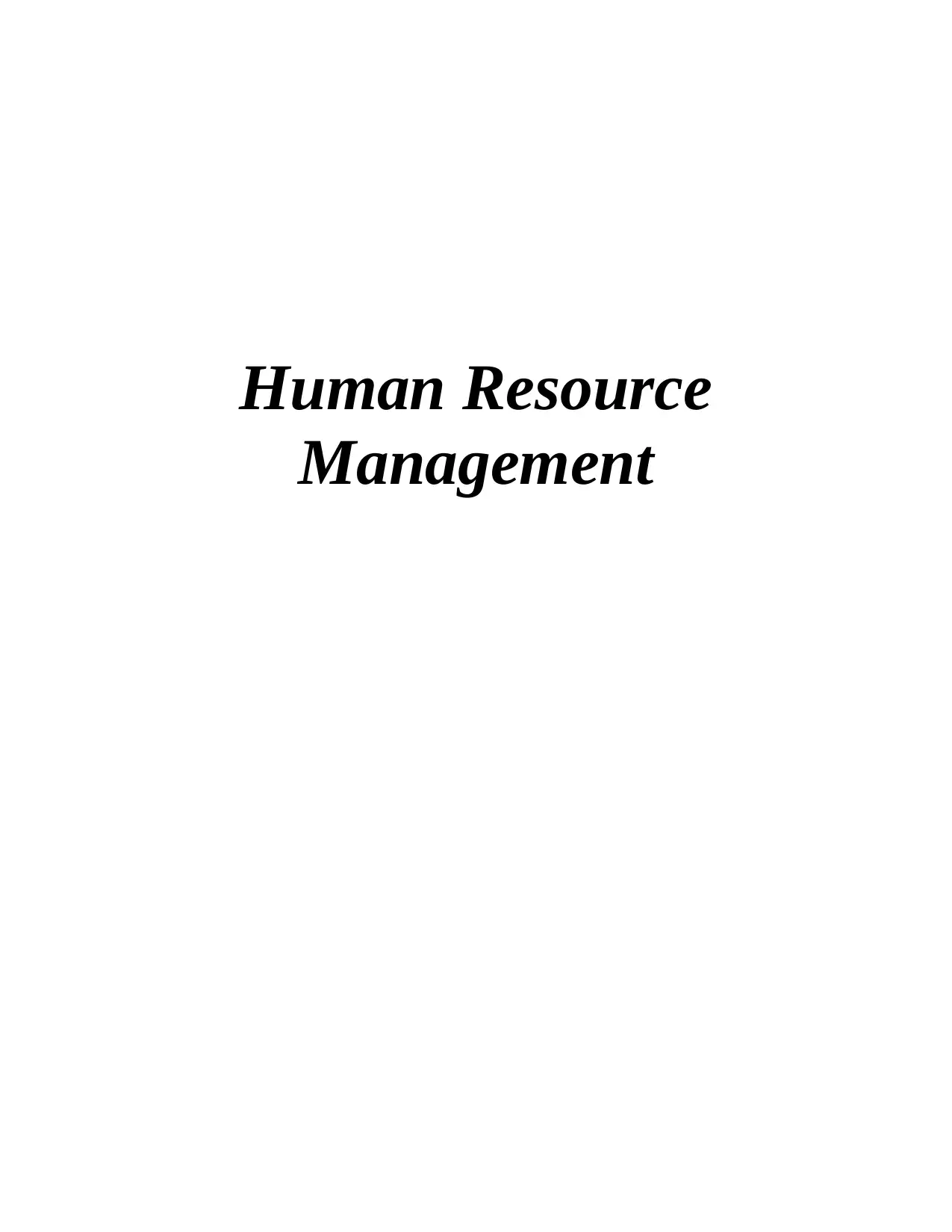
Human Resource
Management
Management
Paraphrase This Document
Need a fresh take? Get an instant paraphrase of this document with our AI Paraphraser
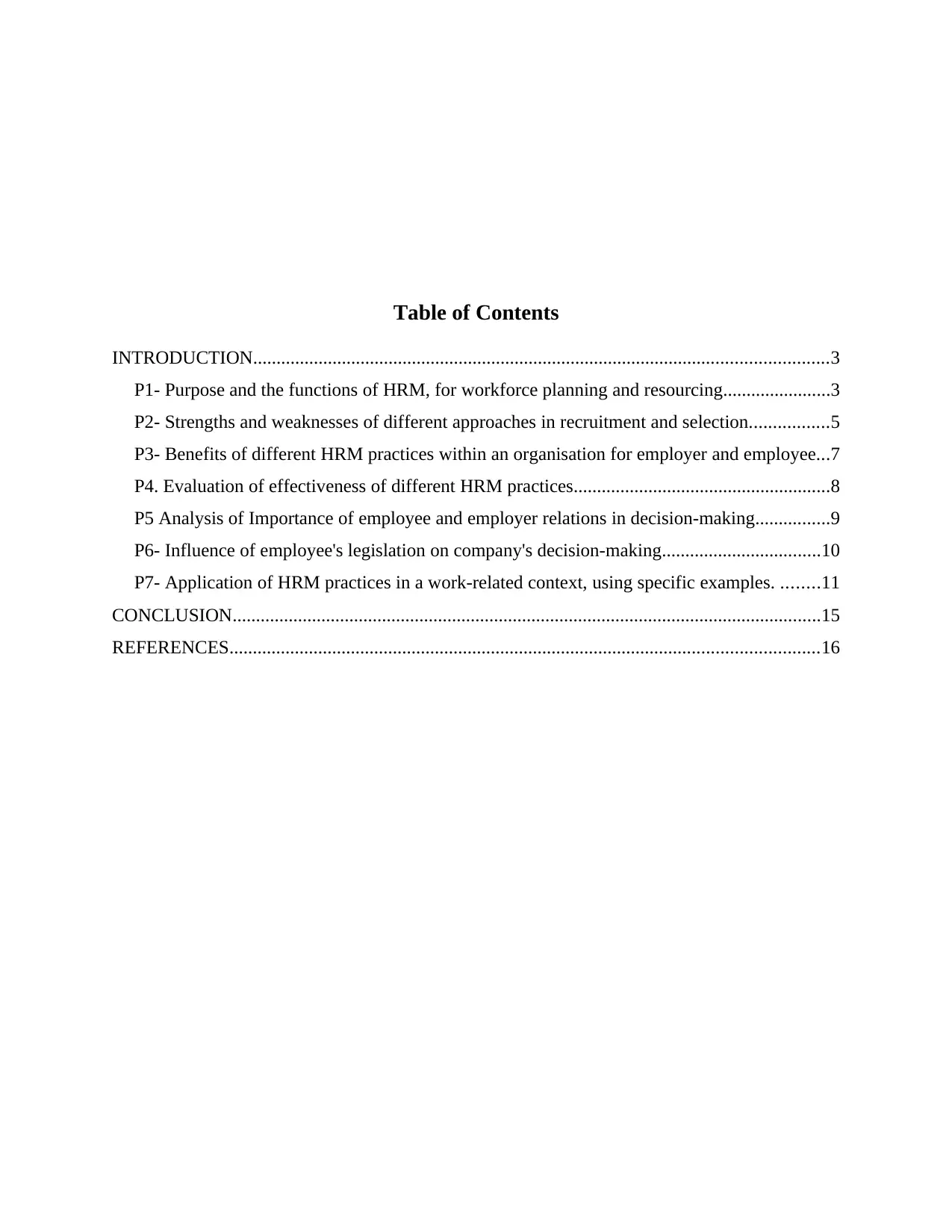
Table of Contents
INTRODUCTION...........................................................................................................................3
P1- Purpose and the functions of HRM, for workforce planning and resourcing.......................3
P2- Strengths and weaknesses of different approaches in recruitment and selection.................5
P3- Benefits of different HRM practices within an organisation for employer and employee...7
P4. Evaluation of effectiveness of different HRM practices.......................................................8
P5 Analysis of Importance of employee and employer relations in decision-making................9
P6- Influence of employee's legislation on company's decision-making..................................10
P7- Application of HRM practices in a work-related context, using specific examples. ........11
CONCLUSION..............................................................................................................................15
REFERENCES..............................................................................................................................16
INTRODUCTION...........................................................................................................................3
P1- Purpose and the functions of HRM, for workforce planning and resourcing.......................3
P2- Strengths and weaknesses of different approaches in recruitment and selection.................5
P3- Benefits of different HRM practices within an organisation for employer and employee...7
P4. Evaluation of effectiveness of different HRM practices.......................................................8
P5 Analysis of Importance of employee and employer relations in decision-making................9
P6- Influence of employee's legislation on company's decision-making..................................10
P7- Application of HRM practices in a work-related context, using specific examples. ........11
CONCLUSION..............................................................................................................................15
REFERENCES..............................................................................................................................16
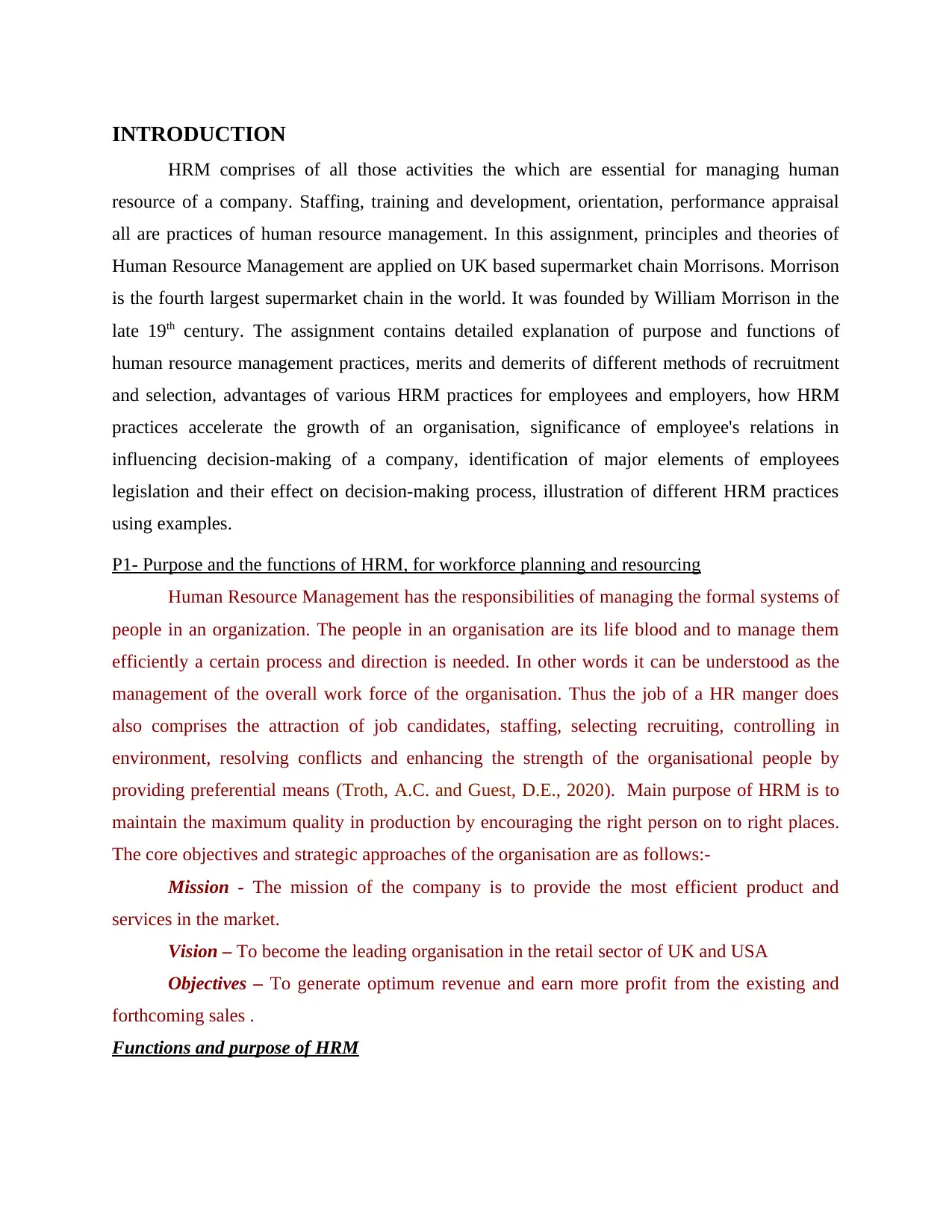
INTRODUCTION
HRM comprises of all those activities the which are essential for managing human
resource of a company. Staffing, training and development, orientation, performance appraisal
all are practices of human resource management. In this assignment, principles and theories of
Human Resource Management are applied on UK based supermarket chain Morrisons. Morrison
is the fourth largest supermarket chain in the world. It was founded by William Morrison in the
late 19th century. The assignment contains detailed explanation of purpose and functions of
human resource management practices, merits and demerits of different methods of recruitment
and selection, advantages of various HRM practices for employees and employers, how HRM
practices accelerate the growth of an organisation, significance of employee's relations in
influencing decision-making of a company, identification of major elements of employees
legislation and their effect on decision-making process, illustration of different HRM practices
using examples.
P1- Purpose and the functions of HRM, for workforce planning and resourcing
Human Resource Management has the responsibilities of managing the formal systems of
people in an organization. The people in an organisation are its life blood and to manage them
efficiently a certain process and direction is needed. In other words it can be understood as the
management of the overall work force of the organisation. Thus the job of a HR manger does
also comprises the attraction of job candidates, staffing, selecting recruiting, controlling in
environment, resolving conflicts and enhancing the strength of the organisational people by
providing preferential means (Troth, A.C. and Guest, D.E., 2020). Main purpose of HRM is to
maintain the maximum quality in production by encouraging the right person on to right places.
The core objectives and strategic approaches of the organisation are as follows:-
Mission - The mission of the company is to provide the most efficient product and
services in the market.
Vision – To become the leading organisation in the retail sector of UK and USA
Objectives – To generate optimum revenue and earn more profit from the existing and
forthcoming sales .
Functions and purpose of HRM
HRM comprises of all those activities the which are essential for managing human
resource of a company. Staffing, training and development, orientation, performance appraisal
all are practices of human resource management. In this assignment, principles and theories of
Human Resource Management are applied on UK based supermarket chain Morrisons. Morrison
is the fourth largest supermarket chain in the world. It was founded by William Morrison in the
late 19th century. The assignment contains detailed explanation of purpose and functions of
human resource management practices, merits and demerits of different methods of recruitment
and selection, advantages of various HRM practices for employees and employers, how HRM
practices accelerate the growth of an organisation, significance of employee's relations in
influencing decision-making of a company, identification of major elements of employees
legislation and their effect on decision-making process, illustration of different HRM practices
using examples.
P1- Purpose and the functions of HRM, for workforce planning and resourcing
Human Resource Management has the responsibilities of managing the formal systems of
people in an organization. The people in an organisation are its life blood and to manage them
efficiently a certain process and direction is needed. In other words it can be understood as the
management of the overall work force of the organisation. Thus the job of a HR manger does
also comprises the attraction of job candidates, staffing, selecting recruiting, controlling in
environment, resolving conflicts and enhancing the strength of the organisational people by
providing preferential means (Troth, A.C. and Guest, D.E., 2020). Main purpose of HRM is to
maintain the maximum quality in production by encouraging the right person on to right places.
The core objectives and strategic approaches of the organisation are as follows:-
Mission - The mission of the company is to provide the most efficient product and
services in the market.
Vision – To become the leading organisation in the retail sector of UK and USA
Objectives – To generate optimum revenue and earn more profit from the existing and
forthcoming sales .
Functions and purpose of HRM
⊘ This is a preview!⊘
Do you want full access?
Subscribe today to unlock all pages.

Trusted by 1+ million students worldwide
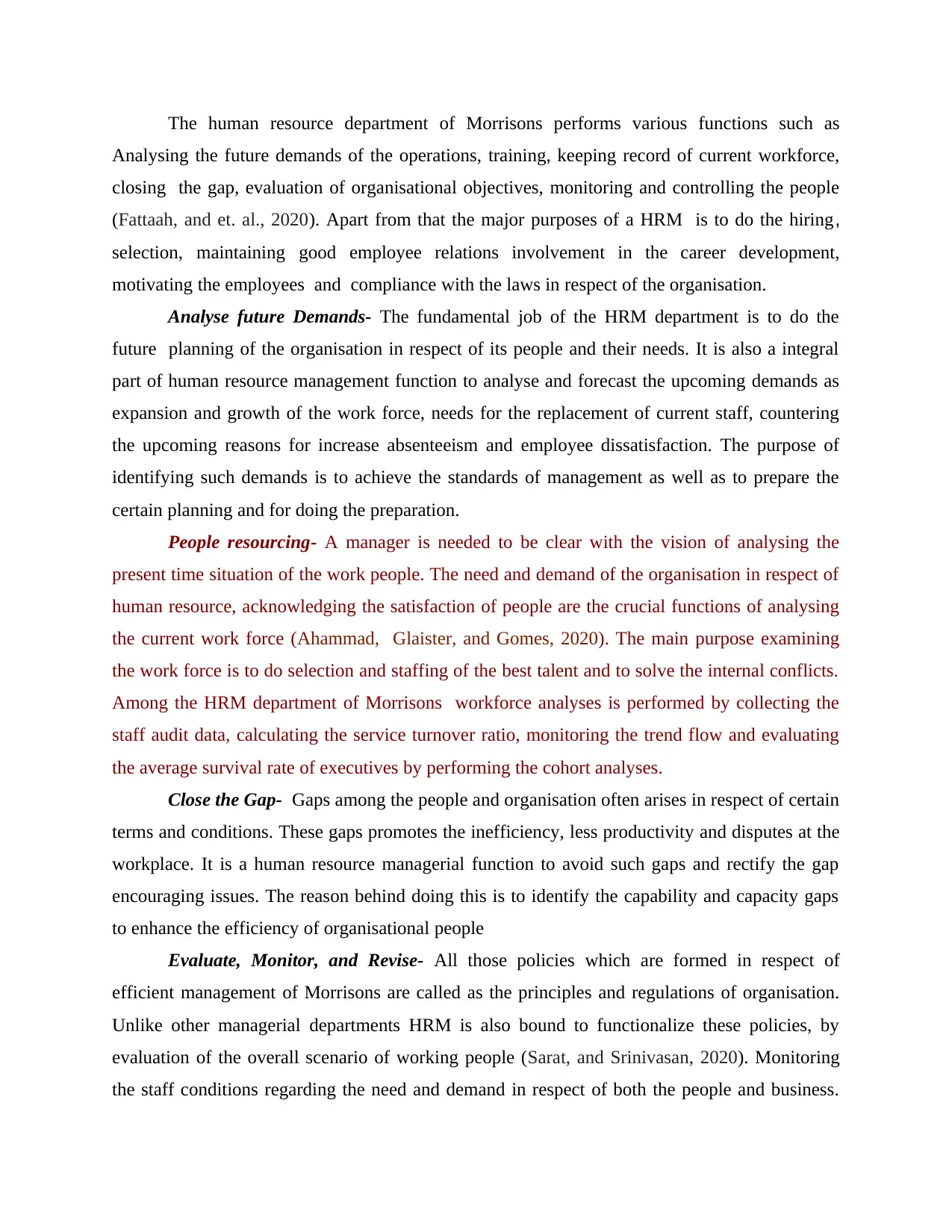
The human resource department of Morrisons performs various functions such as
Analysing the future demands of the operations, training, keeping record of current workforce,
closing the gap, evaluation of organisational objectives, monitoring and controlling the people
(Fattaah, and et. al., 2020). Apart from that the major purposes of a HRM is to do the hiring,
selection, maintaining good employee relations involvement in the career development,
motivating the employees and compliance with the laws in respect of the organisation.
Analyse future Demands- The fundamental job of the HRM department is to do the
future planning of the organisation in respect of its people and their needs. It is also a integral
part of human resource management function to analyse and forecast the upcoming demands as
expansion and growth of the work force, needs for the replacement of current staff, countering
the upcoming reasons for increase absenteeism and employee dissatisfaction. The purpose of
identifying such demands is to achieve the standards of management as well as to prepare the
certain planning and for doing the preparation.
People resourcing- A manager is needed to be clear with the vision of analysing the
present time situation of the work people. The need and demand of the organisation in respect of
human resource, acknowledging the satisfaction of people are the crucial functions of analysing
the current work force (Ahammad, Glaister, and Gomes, 2020). The main purpose examining
the work force is to do selection and staffing of the best talent and to solve the internal conflicts.
Among the HRM department of Morrisons workforce analyses is performed by collecting the
staff audit data, calculating the service turnover ratio, monitoring the trend flow and evaluating
the average survival rate of executives by performing the cohort analyses.
Close the Gap- Gaps among the people and organisation often arises in respect of certain
terms and conditions. These gaps promotes the inefficiency, less productivity and disputes at the
workplace. It is a human resource managerial function to avoid such gaps and rectify the gap
encouraging issues. The reason behind doing this is to identify the capability and capacity gaps
to enhance the efficiency of organisational people
Evaluate, Monitor, and Revise- All those policies which are formed in respect of
efficient management of Morrisons are called as the principles and regulations of organisation.
Unlike other managerial departments HRM is also bound to functionalize these policies, by
evaluation of the overall scenario of working people (Sarat, and Srinivasan, 2020). Monitoring
the staff conditions regarding the need and demand in respect of both the people and business.
Analysing the future demands of the operations, training, keeping record of current workforce,
closing the gap, evaluation of organisational objectives, monitoring and controlling the people
(Fattaah, and et. al., 2020). Apart from that the major purposes of a HRM is to do the hiring,
selection, maintaining good employee relations involvement in the career development,
motivating the employees and compliance with the laws in respect of the organisation.
Analyse future Demands- The fundamental job of the HRM department is to do the
future planning of the organisation in respect of its people and their needs. It is also a integral
part of human resource management function to analyse and forecast the upcoming demands as
expansion and growth of the work force, needs for the replacement of current staff, countering
the upcoming reasons for increase absenteeism and employee dissatisfaction. The purpose of
identifying such demands is to achieve the standards of management as well as to prepare the
certain planning and for doing the preparation.
People resourcing- A manager is needed to be clear with the vision of analysing the
present time situation of the work people. The need and demand of the organisation in respect of
human resource, acknowledging the satisfaction of people are the crucial functions of analysing
the current work force (Ahammad, Glaister, and Gomes, 2020). The main purpose examining
the work force is to do selection and staffing of the best talent and to solve the internal conflicts.
Among the HRM department of Morrisons workforce analyses is performed by collecting the
staff audit data, calculating the service turnover ratio, monitoring the trend flow and evaluating
the average survival rate of executives by performing the cohort analyses.
Close the Gap- Gaps among the people and organisation often arises in respect of certain
terms and conditions. These gaps promotes the inefficiency, less productivity and disputes at the
workplace. It is a human resource managerial function to avoid such gaps and rectify the gap
encouraging issues. The reason behind doing this is to identify the capability and capacity gaps
to enhance the efficiency of organisational people
Evaluate, Monitor, and Revise- All those policies which are formed in respect of
efficient management of Morrisons are called as the principles and regulations of organisation.
Unlike other managerial departments HRM is also bound to functionalize these policies, by
evaluation of the overall scenario of working people (Sarat, and Srinivasan, 2020). Monitoring
the staff conditions regarding the need and demand in respect of both the people and business.
Paraphrase This Document
Need a fresh take? Get an instant paraphrase of this document with our AI Paraphraser
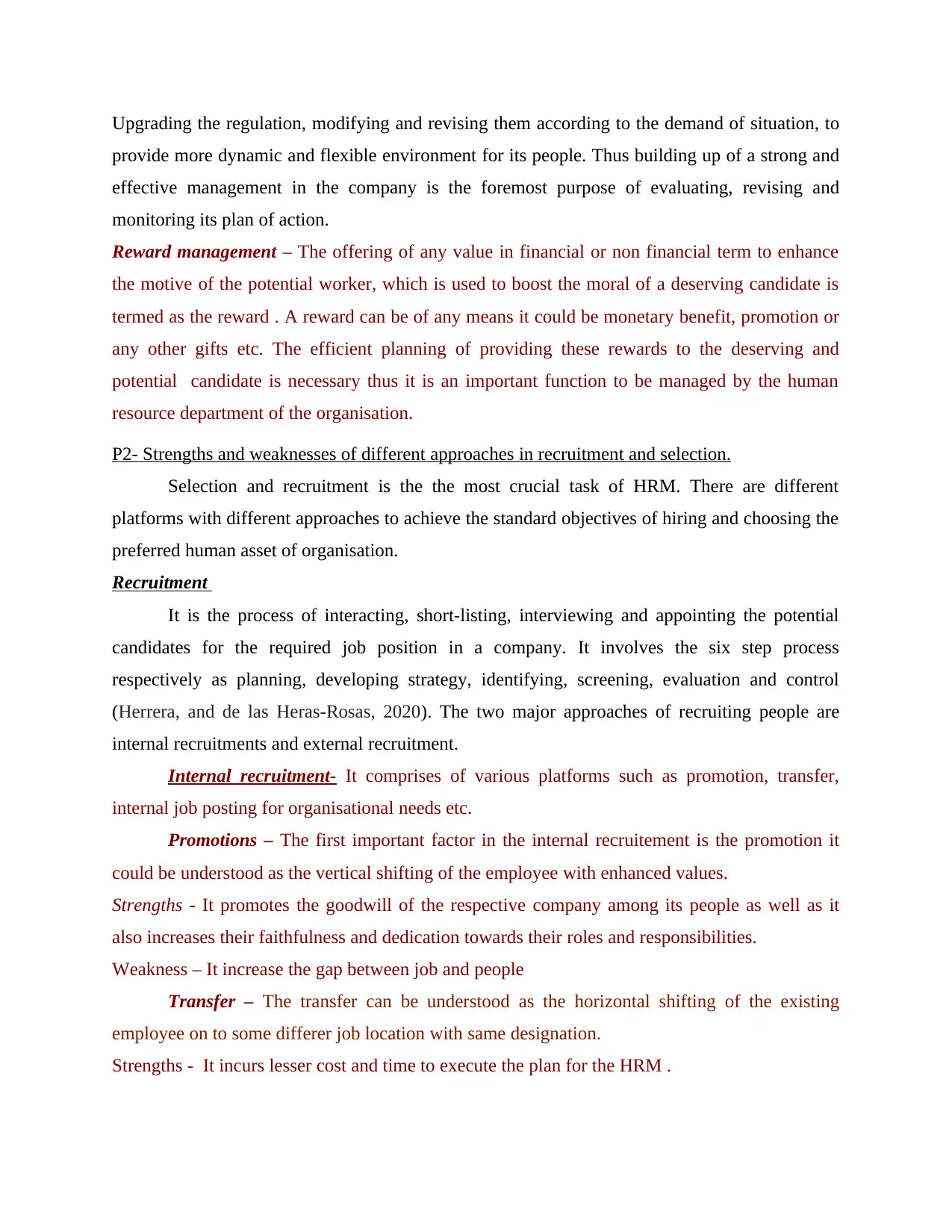
Upgrading the regulation, modifying and revising them according to the demand of situation, to
provide more dynamic and flexible environment for its people. Thus building up of a strong and
effective management in the company is the foremost purpose of evaluating, revising and
monitoring its plan of action.
Reward management – The offering of any value in financial or non financial term to enhance
the motive of the potential worker, which is used to boost the moral of a deserving candidate is
termed as the reward . A reward can be of any means it could be monetary benefit, promotion or
any other gifts etc. The efficient planning of providing these rewards to the deserving and
potential candidate is necessary thus it is an important function to be managed by the human
resource department of the organisation.
P2- Strengths and weaknesses of different approaches in recruitment and selection.
Selection and recruitment is the the most crucial task of HRM. There are different
platforms with different approaches to achieve the standard objectives of hiring and choosing the
preferred human asset of organisation.
Recruitment
It is the process of interacting, short-listing, interviewing and appointing the potential
candidates for the required job position in a company. It involves the six step process
respectively as planning, developing strategy, identifying, screening, evaluation and control
(Herrera, and de las Heras-Rosas, 2020). The two major approaches of recruiting people are
internal recruitments and external recruitment.
Internal recruitment- It comprises of various platforms such as promotion, transfer,
internal job posting for organisational needs etc.
Promotions – The first important factor in the internal recruitement is the promotion it
could be understood as the vertical shifting of the employee with enhanced values.
Strengths - It promotes the goodwill of the respective company among its people as well as it
also increases their faithfulness and dedication towards their roles and responsibilities.
Weakness – It increase the gap between job and people
Transfer – The transfer can be understood as the horizontal shifting of the existing
employee on to some differer job location with same designation.
Strengths - It incurs lesser cost and time to execute the plan for the HRM .
provide more dynamic and flexible environment for its people. Thus building up of a strong and
effective management in the company is the foremost purpose of evaluating, revising and
monitoring its plan of action.
Reward management – The offering of any value in financial or non financial term to enhance
the motive of the potential worker, which is used to boost the moral of a deserving candidate is
termed as the reward . A reward can be of any means it could be monetary benefit, promotion or
any other gifts etc. The efficient planning of providing these rewards to the deserving and
potential candidate is necessary thus it is an important function to be managed by the human
resource department of the organisation.
P2- Strengths and weaknesses of different approaches in recruitment and selection.
Selection and recruitment is the the most crucial task of HRM. There are different
platforms with different approaches to achieve the standard objectives of hiring and choosing the
preferred human asset of organisation.
Recruitment
It is the process of interacting, short-listing, interviewing and appointing the potential
candidates for the required job position in a company. It involves the six step process
respectively as planning, developing strategy, identifying, screening, evaluation and control
(Herrera, and de las Heras-Rosas, 2020). The two major approaches of recruiting people are
internal recruitments and external recruitment.
Internal recruitment- It comprises of various platforms such as promotion, transfer,
internal job posting for organisational needs etc.
Promotions – The first important factor in the internal recruitement is the promotion it
could be understood as the vertical shifting of the employee with enhanced values.
Strengths - It promotes the goodwill of the respective company among its people as well as it
also increases their faithfulness and dedication towards their roles and responsibilities.
Weakness – It increase the gap between job and people
Transfer – The transfer can be understood as the horizontal shifting of the existing
employee on to some differer job location with same designation.
Strengths - It incurs lesser cost and time to execute the plan for the HRM .
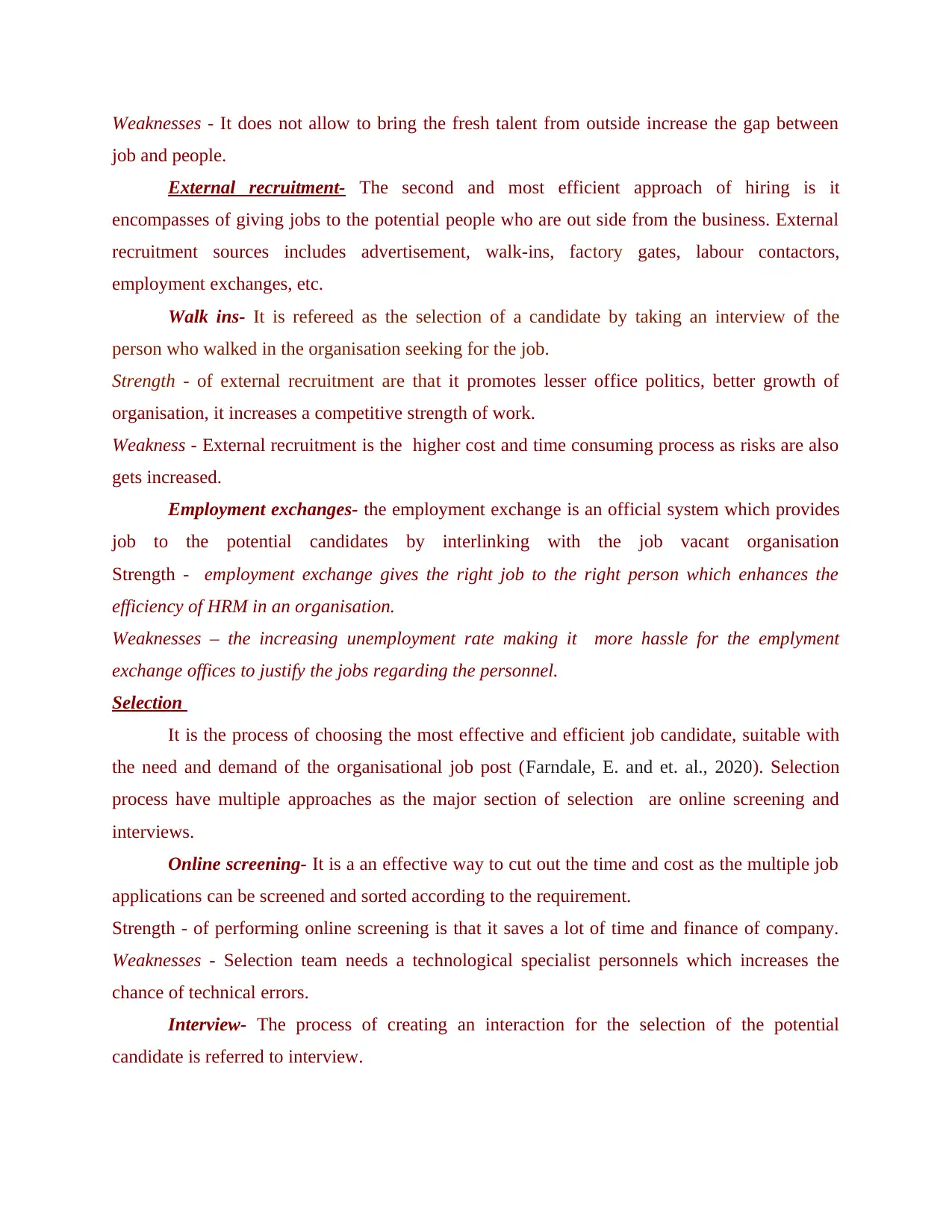
Weaknesses - It does not allow to bring the fresh talent from outside increase the gap between
job and people.
External recruitment- The second and most efficient approach of hiring is it
encompasses of giving jobs to the potential people who are out side from the business. External
recruitment sources includes advertisement, walk-ins, factory gates, labour contactors,
employment exchanges, etc.
Walk ins- It is refereed as the selection of a candidate by taking an interview of the
person who walked in the organisation seeking for the job.
Strength - of external recruitment are that it promotes lesser office politics, better growth of
organisation, it increases a competitive strength of work.
Weakness - External recruitment is the higher cost and time consuming process as risks are also
gets increased.
Employment exchanges- the employment exchange is an official system which provides
job to the potential candidates by interlinking with the job vacant organisation
Strength - employment exchange gives the right job to the right person which enhances the
efficiency of HRM in an organisation.
Weaknesses – the increasing unemployment rate making it more hassle for the emplyment
exchange offices to justify the jobs regarding the personnel.
Selection
It is the process of choosing the most effective and efficient job candidate, suitable with
the need and demand of the organisational job post (Farndale, E. and et. al., 2020). Selection
process have multiple approaches as the major section of selection are online screening and
interviews.
Online screening- It is a an effective way to cut out the time and cost as the multiple job
applications can be screened and sorted according to the requirement.
Strength - of performing online screening is that it saves a lot of time and finance of company.
Weaknesses - Selection team needs a technological specialist personnels which increases the
chance of technical errors.
Interview- The process of creating an interaction for the selection of the potential
candidate is referred to interview.
job and people.
External recruitment- The second and most efficient approach of hiring is it
encompasses of giving jobs to the potential people who are out side from the business. External
recruitment sources includes advertisement, walk-ins, factory gates, labour contactors,
employment exchanges, etc.
Walk ins- It is refereed as the selection of a candidate by taking an interview of the
person who walked in the organisation seeking for the job.
Strength - of external recruitment are that it promotes lesser office politics, better growth of
organisation, it increases a competitive strength of work.
Weakness - External recruitment is the higher cost and time consuming process as risks are also
gets increased.
Employment exchanges- the employment exchange is an official system which provides
job to the potential candidates by interlinking with the job vacant organisation
Strength - employment exchange gives the right job to the right person which enhances the
efficiency of HRM in an organisation.
Weaknesses – the increasing unemployment rate making it more hassle for the emplyment
exchange offices to justify the jobs regarding the personnel.
Selection
It is the process of choosing the most effective and efficient job candidate, suitable with
the need and demand of the organisational job post (Farndale, E. and et. al., 2020). Selection
process have multiple approaches as the major section of selection are online screening and
interviews.
Online screening- It is a an effective way to cut out the time and cost as the multiple job
applications can be screened and sorted according to the requirement.
Strength - of performing online screening is that it saves a lot of time and finance of company.
Weaknesses - Selection team needs a technological specialist personnels which increases the
chance of technical errors.
Interview- The process of creating an interaction for the selection of the potential
candidate is referred to interview.
⊘ This is a preview!⊘
Do you want full access?
Subscribe today to unlock all pages.

Trusted by 1+ million students worldwide
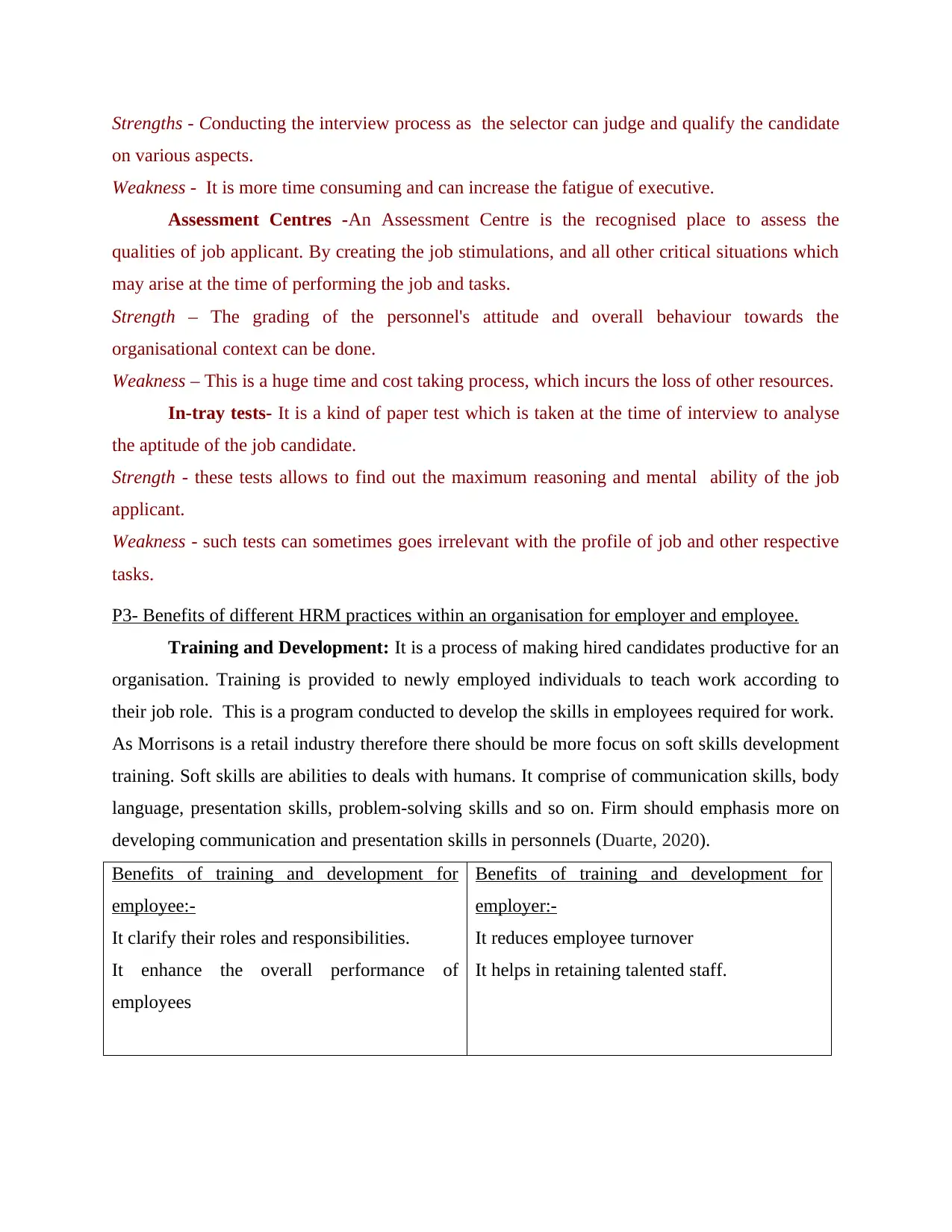
Strengths - Conducting the interview process as the selector can judge and qualify the candidate
on various aspects.
Weakness - It is more time consuming and can increase the fatigue of executive.
Assessment Centres -An Assessment Centre is the recognised place to assess the
qualities of job applicant. By creating the job stimulations, and all other critical situations which
may arise at the time of performing the job and tasks.
Strength – The grading of the personnel's attitude and overall behaviour towards the
organisational context can be done.
Weakness – This is a huge time and cost taking process, which incurs the loss of other resources.
In-tray tests- It is a kind of paper test which is taken at the time of interview to analyse
the aptitude of the job candidate.
Strength - these tests allows to find out the maximum reasoning and mental ability of the job
applicant.
Weakness - such tests can sometimes goes irrelevant with the profile of job and other respective
tasks.
P3- Benefits of different HRM practices within an organisation for employer and employee.
Training and Development: It is a process of making hired candidates productive for an
organisation. Training is provided to newly employed individuals to teach work according to
their job role. This is a program conducted to develop the skills in employees required for work.
As Morrisons is a retail industry therefore there should be more focus on soft skills development
training. Soft skills are abilities to deals with humans. It comprise of communication skills, body
language, presentation skills, problem-solving skills and so on. Firm should emphasis more on
developing communication and presentation skills in personnels (Duarte, 2020).
Benefits of training and development for
employee:-
It clarify their roles and responsibilities.
It enhance the overall performance of
employees
Benefits of training and development for
employer:-
It reduces employee turnover
It helps in retaining talented staff.
on various aspects.
Weakness - It is more time consuming and can increase the fatigue of executive.
Assessment Centres -An Assessment Centre is the recognised place to assess the
qualities of job applicant. By creating the job stimulations, and all other critical situations which
may arise at the time of performing the job and tasks.
Strength – The grading of the personnel's attitude and overall behaviour towards the
organisational context can be done.
Weakness – This is a huge time and cost taking process, which incurs the loss of other resources.
In-tray tests- It is a kind of paper test which is taken at the time of interview to analyse
the aptitude of the job candidate.
Strength - these tests allows to find out the maximum reasoning and mental ability of the job
applicant.
Weakness - such tests can sometimes goes irrelevant with the profile of job and other respective
tasks.
P3- Benefits of different HRM practices within an organisation for employer and employee.
Training and Development: It is a process of making hired candidates productive for an
organisation. Training is provided to newly employed individuals to teach work according to
their job role. This is a program conducted to develop the skills in employees required for work.
As Morrisons is a retail industry therefore there should be more focus on soft skills development
training. Soft skills are abilities to deals with humans. It comprise of communication skills, body
language, presentation skills, problem-solving skills and so on. Firm should emphasis more on
developing communication and presentation skills in personnels (Duarte, 2020).
Benefits of training and development for
employee:-
It clarify their roles and responsibilities.
It enhance the overall performance of
employees
Benefits of training and development for
employer:-
It reduces employee turnover
It helps in retaining talented staff.
Paraphrase This Document
Need a fresh take? Get an instant paraphrase of this document with our AI Paraphraser
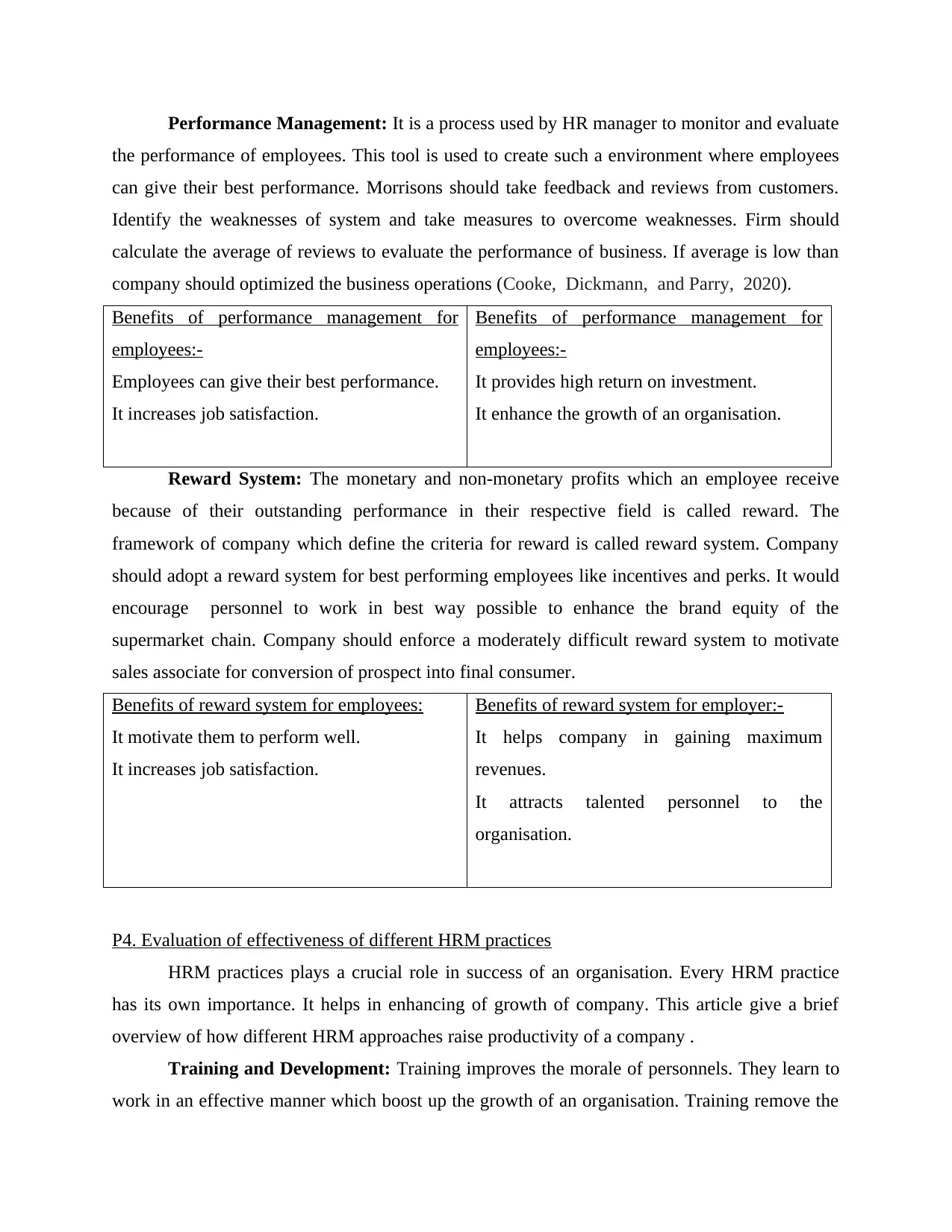
Performance Management: It is a process used by HR manager to monitor and evaluate
the performance of employees. This tool is used to create such a environment where employees
can give their best performance. Morrisons should take feedback and reviews from customers.
Identify the weaknesses of system and take measures to overcome weaknesses. Firm should
calculate the average of reviews to evaluate the performance of business. If average is low than
company should optimized the business operations (Cooke, Dickmann, and Parry, 2020).
Benefits of performance management for
employees:-
Employees can give their best performance.
It increases job satisfaction.
Benefits of performance management for
employees:-
It provides high return on investment.
It enhance the growth of an organisation.
Reward System: The monetary and non-monetary profits which an employee receive
because of their outstanding performance in their respective field is called reward. The
framework of company which define the criteria for reward is called reward system. Company
should adopt a reward system for best performing employees like incentives and perks. It would
encourage personnel to work in best way possible to enhance the brand equity of the
supermarket chain. Company should enforce a moderately difficult reward system to motivate
sales associate for conversion of prospect into final consumer.
Benefits of reward system for employees:
It motivate them to perform well.
It increases job satisfaction.
Benefits of reward system for employer:-
It helps company in gaining maximum
revenues.
It attracts talented personnel to the
organisation.
P4. Evaluation of effectiveness of different HRM practices
HRM practices plays a crucial role in success of an organisation. Every HRM practice
has its own importance. It helps in enhancing of growth of company. This article give a brief
overview of how different HRM approaches raise productivity of a company .
Training and Development: Training improves the morale of personnels. They learn to
work in an effective manner which boost up the growth of an organisation. Training remove the
the performance of employees. This tool is used to create such a environment where employees
can give their best performance. Morrisons should take feedback and reviews from customers.
Identify the weaknesses of system and take measures to overcome weaknesses. Firm should
calculate the average of reviews to evaluate the performance of business. If average is low than
company should optimized the business operations (Cooke, Dickmann, and Parry, 2020).
Benefits of performance management for
employees:-
Employees can give their best performance.
It increases job satisfaction.
Benefits of performance management for
employees:-
It provides high return on investment.
It enhance the growth of an organisation.
Reward System: The monetary and non-monetary profits which an employee receive
because of their outstanding performance in their respective field is called reward. The
framework of company which define the criteria for reward is called reward system. Company
should adopt a reward system for best performing employees like incentives and perks. It would
encourage personnel to work in best way possible to enhance the brand equity of the
supermarket chain. Company should enforce a moderately difficult reward system to motivate
sales associate for conversion of prospect into final consumer.
Benefits of reward system for employees:
It motivate them to perform well.
It increases job satisfaction.
Benefits of reward system for employer:-
It helps company in gaining maximum
revenues.
It attracts talented personnel to the
organisation.
P4. Evaluation of effectiveness of different HRM practices
HRM practices plays a crucial role in success of an organisation. Every HRM practice
has its own importance. It helps in enhancing of growth of company. This article give a brief
overview of how different HRM approaches raise productivity of a company .
Training and Development: Training improves the morale of personnels. They learn to
work in an effective manner which boost up the growth of an organisation. Training remove the
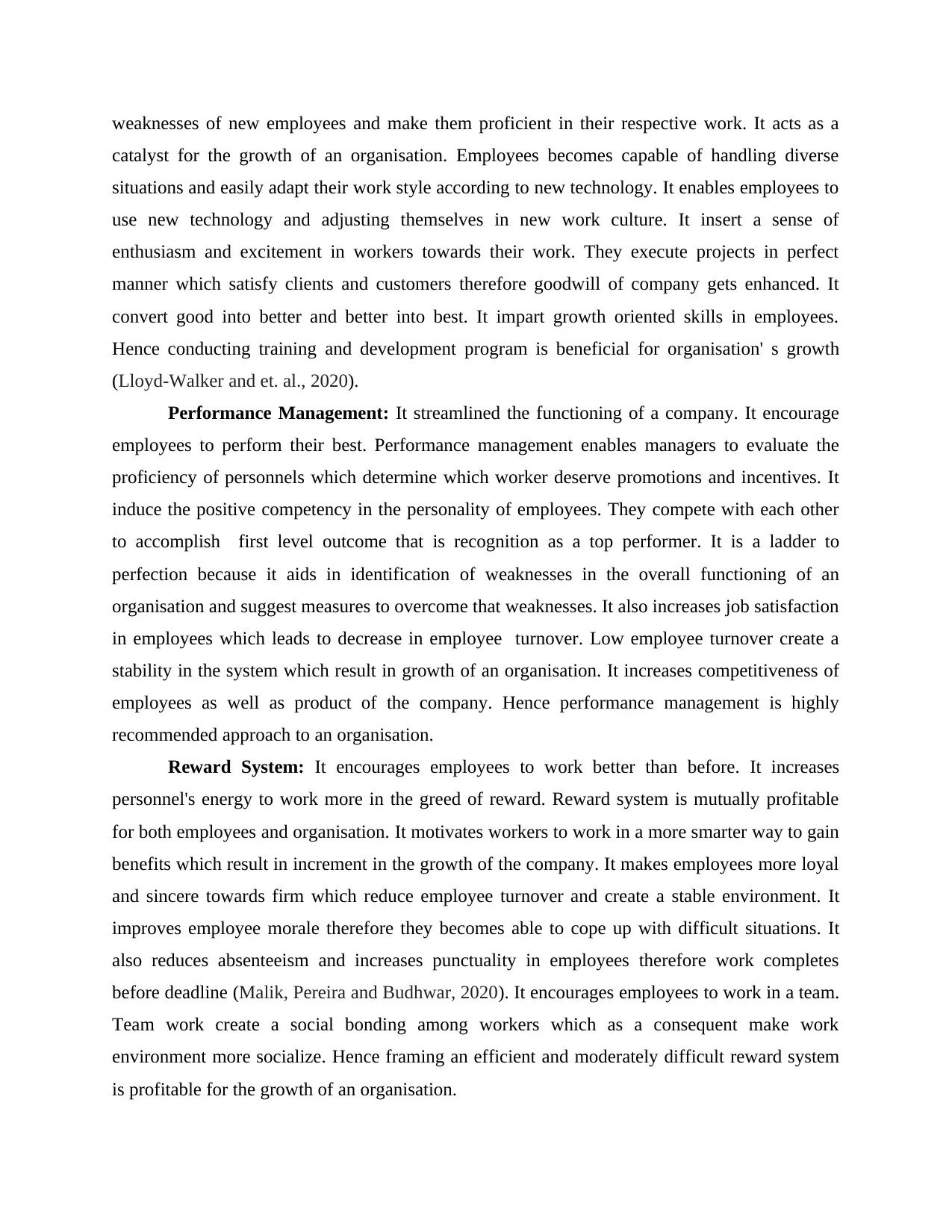
weaknesses of new employees and make them proficient in their respective work. It acts as a
catalyst for the growth of an organisation. Employees becomes capable of handling diverse
situations and easily adapt their work style according to new technology. It enables employees to
use new technology and adjusting themselves in new work culture. It insert a sense of
enthusiasm and excitement in workers towards their work. They execute projects in perfect
manner which satisfy clients and customers therefore goodwill of company gets enhanced. It
convert good into better and better into best. It impart growth oriented skills in employees.
Hence conducting training and development program is beneficial for organisation' s growth
(Lloyd-Walker and et. al., 2020).
Performance Management: It streamlined the functioning of a company. It encourage
employees to perform their best. Performance management enables managers to evaluate the
proficiency of personnels which determine which worker deserve promotions and incentives. It
induce the positive competency in the personality of employees. They compete with each other
to accomplish first level outcome that is recognition as a top performer. It is a ladder to
perfection because it aids in identification of weaknesses in the overall functioning of an
organisation and suggest measures to overcome that weaknesses. It also increases job satisfaction
in employees which leads to decrease in employee turnover. Low employee turnover create a
stability in the system which result in growth of an organisation. It increases competitiveness of
employees as well as product of the company. Hence performance management is highly
recommended approach to an organisation.
Reward System: It encourages employees to work better than before. It increases
personnel's energy to work more in the greed of reward. Reward system is mutually profitable
for both employees and organisation. It motivates workers to work in a more smarter way to gain
benefits which result in increment in the growth of the company. It makes employees more loyal
and sincere towards firm which reduce employee turnover and create a stable environment. It
improves employee morale therefore they becomes able to cope up with difficult situations. It
also reduces absenteeism and increases punctuality in employees therefore work completes
before deadline (Malik, Pereira and Budhwar, 2020). It encourages employees to work in a team.
Team work create a social bonding among workers which as a consequent make work
environment more socialize. Hence framing an efficient and moderately difficult reward system
is profitable for the growth of an organisation.
catalyst for the growth of an organisation. Employees becomes capable of handling diverse
situations and easily adapt their work style according to new technology. It enables employees to
use new technology and adjusting themselves in new work culture. It insert a sense of
enthusiasm and excitement in workers towards their work. They execute projects in perfect
manner which satisfy clients and customers therefore goodwill of company gets enhanced. It
convert good into better and better into best. It impart growth oriented skills in employees.
Hence conducting training and development program is beneficial for organisation' s growth
(Lloyd-Walker and et. al., 2020).
Performance Management: It streamlined the functioning of a company. It encourage
employees to perform their best. Performance management enables managers to evaluate the
proficiency of personnels which determine which worker deserve promotions and incentives. It
induce the positive competency in the personality of employees. They compete with each other
to accomplish first level outcome that is recognition as a top performer. It is a ladder to
perfection because it aids in identification of weaknesses in the overall functioning of an
organisation and suggest measures to overcome that weaknesses. It also increases job satisfaction
in employees which leads to decrease in employee turnover. Low employee turnover create a
stability in the system which result in growth of an organisation. It increases competitiveness of
employees as well as product of the company. Hence performance management is highly
recommended approach to an organisation.
Reward System: It encourages employees to work better than before. It increases
personnel's energy to work more in the greed of reward. Reward system is mutually profitable
for both employees and organisation. It motivates workers to work in a more smarter way to gain
benefits which result in increment in the growth of the company. It makes employees more loyal
and sincere towards firm which reduce employee turnover and create a stable environment. It
improves employee morale therefore they becomes able to cope up with difficult situations. It
also reduces absenteeism and increases punctuality in employees therefore work completes
before deadline (Malik, Pereira and Budhwar, 2020). It encourages employees to work in a team.
Team work create a social bonding among workers which as a consequent make work
environment more socialize. Hence framing an efficient and moderately difficult reward system
is profitable for the growth of an organisation.
⊘ This is a preview!⊘
Do you want full access?
Subscribe today to unlock all pages.

Trusted by 1+ million students worldwide
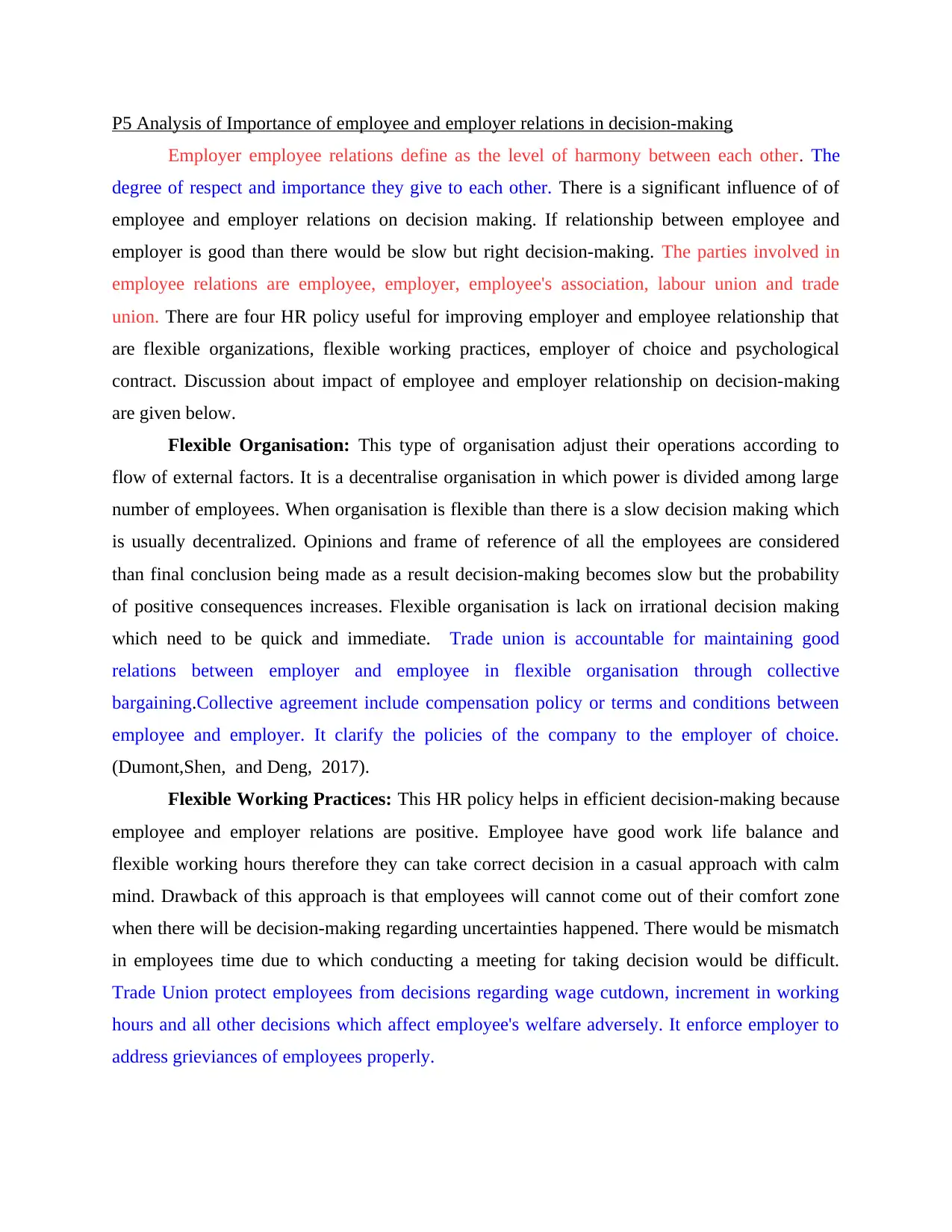
P5 Analysis of Importance of employee and employer relations in decision-making
Employer employee relations define as the level of harmony between each other. The
degree of respect and importance they give to each other. There is a significant influence of of
employee and employer relations on decision making. If relationship between employee and
employer is good than there would be slow but right decision-making. The parties involved in
employee relations are employee, employer, employee's association, labour union and trade
union. There are four HR policy useful for improving employer and employee relationship that
are flexible organizations, flexible working practices, employer of choice and psychological
contract. Discussion about impact of employee and employer relationship on decision-making
are given below.
Flexible Organisation: This type of organisation adjust their operations according to
flow of external factors. It is a decentralise organisation in which power is divided among large
number of employees. When organisation is flexible than there is a slow decision making which
is usually decentralized. Opinions and frame of reference of all the employees are considered
than final conclusion being made as a result decision-making becomes slow but the probability
of positive consequences increases. Flexible organisation is lack on irrational decision making
which need to be quick and immediate. Trade union is accountable for maintaining good
relations between employer and employee in flexible organisation through collective
bargaining.Collective agreement include compensation policy or terms and conditions between
employee and employer. It clarify the policies of the company to the employer of choice.
(Dumont,Shen, and Deng, 2017).
Flexible Working Practices: This HR policy helps in efficient decision-making because
employee and employer relations are positive. Employee have good work life balance and
flexible working hours therefore they can take correct decision in a casual approach with calm
mind. Drawback of this approach is that employees will cannot come out of their comfort zone
when there will be decision-making regarding uncertainties happened. There would be mismatch
in employees time due to which conducting a meeting for taking decision would be difficult.
Trade Union protect employees from decisions regarding wage cutdown, increment in working
hours and all other decisions which affect employee's welfare adversely. It enforce employer to
address grieviances of employees properly.
Employer employee relations define as the level of harmony between each other. The
degree of respect and importance they give to each other. There is a significant influence of of
employee and employer relations on decision making. If relationship between employee and
employer is good than there would be slow but right decision-making. The parties involved in
employee relations are employee, employer, employee's association, labour union and trade
union. There are four HR policy useful for improving employer and employee relationship that
are flexible organizations, flexible working practices, employer of choice and psychological
contract. Discussion about impact of employee and employer relationship on decision-making
are given below.
Flexible Organisation: This type of organisation adjust their operations according to
flow of external factors. It is a decentralise organisation in which power is divided among large
number of employees. When organisation is flexible than there is a slow decision making which
is usually decentralized. Opinions and frame of reference of all the employees are considered
than final conclusion being made as a result decision-making becomes slow but the probability
of positive consequences increases. Flexible organisation is lack on irrational decision making
which need to be quick and immediate. Trade union is accountable for maintaining good
relations between employer and employee in flexible organisation through collective
bargaining.Collective agreement include compensation policy or terms and conditions between
employee and employer. It clarify the policies of the company to the employer of choice.
(Dumont,Shen, and Deng, 2017).
Flexible Working Practices: This HR policy helps in efficient decision-making because
employee and employer relations are positive. Employee have good work life balance and
flexible working hours therefore they can take correct decision in a casual approach with calm
mind. Drawback of this approach is that employees will cannot come out of their comfort zone
when there will be decision-making regarding uncertainties happened. There would be mismatch
in employees time due to which conducting a meeting for taking decision would be difficult.
Trade Union protect employees from decisions regarding wage cutdown, increment in working
hours and all other decisions which affect employee's welfare adversely. It enforce employer to
address grieviances of employees properly.
Paraphrase This Document
Need a fresh take? Get an instant paraphrase of this document with our AI Paraphraser
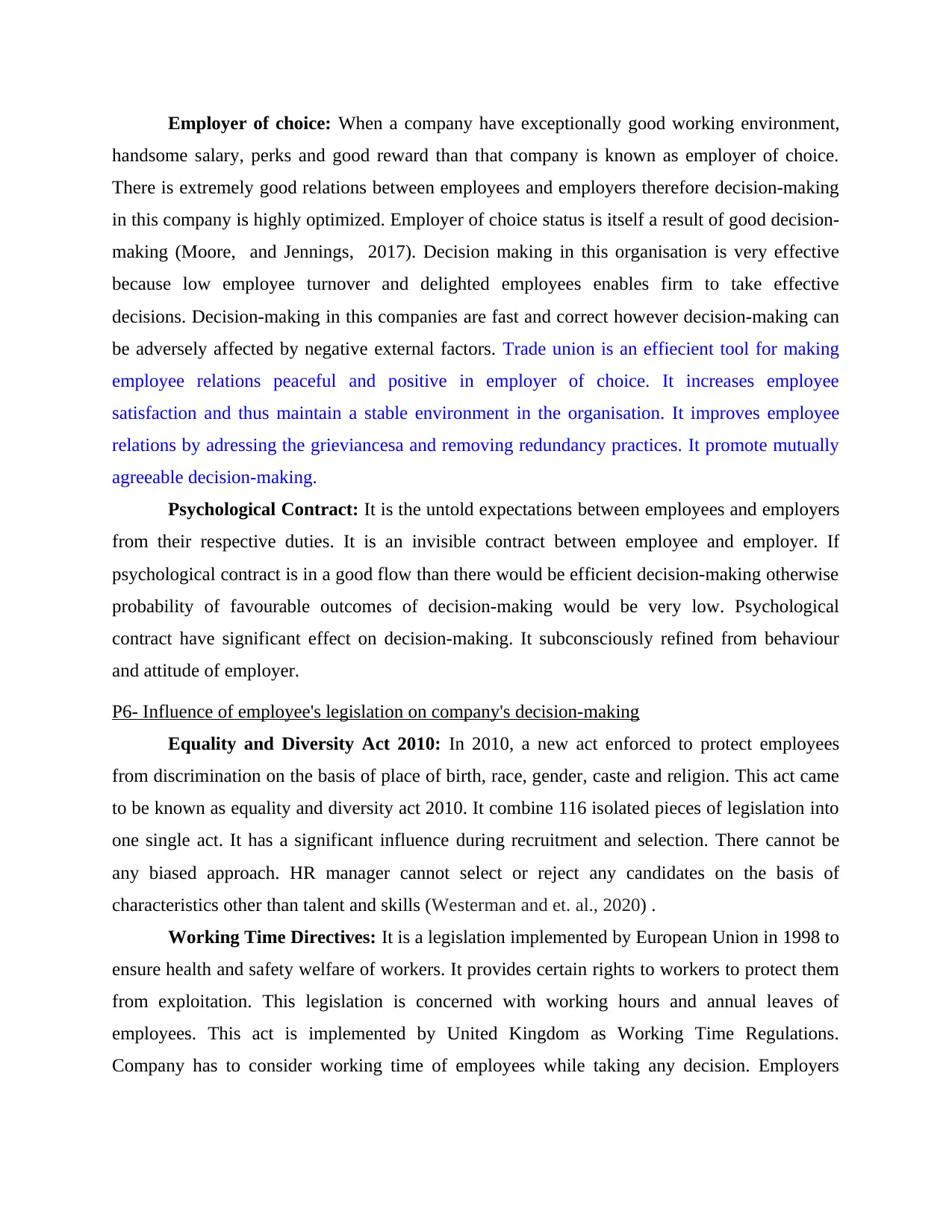
Employer of choice: When a company have exceptionally good working environment,
handsome salary, perks and good reward than that company is known as employer of choice.
There is extremely good relations between employees and employers therefore decision-making
in this company is highly optimized. Employer of choice status is itself a result of good decision-
making (Moore, and Jennings, 2017). Decision making in this organisation is very effective
because low employee turnover and delighted employees enables firm to take effective
decisions. Decision-making in this companies are fast and correct however decision-making can
be adversely affected by negative external factors. Trade union is an effiecient tool for making
employee relations peaceful and positive in employer of choice. It increases employee
satisfaction and thus maintain a stable environment in the organisation. It improves employee
relations by adressing the grieviancesa and removing redundancy practices. It promote mutually
agreeable decision-making.
Psychological Contract: It is the untold expectations between employees and employers
from their respective duties. It is an invisible contract between employee and employer. If
psychological contract is in a good flow than there would be efficient decision-making otherwise
probability of favourable outcomes of decision-making would be very low. Psychological
contract have significant effect on decision-making. It subconsciously refined from behaviour
and attitude of employer.
P6- Influence of employee's legislation on company's decision-making
Equality and Diversity Act 2010: In 2010, a new act enforced to protect employees
from discrimination on the basis of place of birth, race, gender, caste and religion. This act came
to be known as equality and diversity act 2010. It combine 116 isolated pieces of legislation into
one single act. It has a significant influence during recruitment and selection. There cannot be
any biased approach. HR manager cannot select or reject any candidates on the basis of
characteristics other than talent and skills (Westerman and et. al., 2020) .
Working Time Directives: It is a legislation implemented by European Union in 1998 to
ensure health and safety welfare of workers. It provides certain rights to workers to protect them
from exploitation. This legislation is concerned with working hours and annual leaves of
employees. This act is implemented by United Kingdom as Working Time Regulations.
Company has to consider working time of employees while taking any decision. Employers
handsome salary, perks and good reward than that company is known as employer of choice.
There is extremely good relations between employees and employers therefore decision-making
in this company is highly optimized. Employer of choice status is itself a result of good decision-
making (Moore, and Jennings, 2017). Decision making in this organisation is very effective
because low employee turnover and delighted employees enables firm to take effective
decisions. Decision-making in this companies are fast and correct however decision-making can
be adversely affected by negative external factors. Trade union is an effiecient tool for making
employee relations peaceful and positive in employer of choice. It increases employee
satisfaction and thus maintain a stable environment in the organisation. It improves employee
relations by adressing the grieviancesa and removing redundancy practices. It promote mutually
agreeable decision-making.
Psychological Contract: It is the untold expectations between employees and employers
from their respective duties. It is an invisible contract between employee and employer. If
psychological contract is in a good flow than there would be efficient decision-making otherwise
probability of favourable outcomes of decision-making would be very low. Psychological
contract have significant effect on decision-making. It subconsciously refined from behaviour
and attitude of employer.
P6- Influence of employee's legislation on company's decision-making
Equality and Diversity Act 2010: In 2010, a new act enforced to protect employees
from discrimination on the basis of place of birth, race, gender, caste and religion. This act came
to be known as equality and diversity act 2010. It combine 116 isolated pieces of legislation into
one single act. It has a significant influence during recruitment and selection. There cannot be
any biased approach. HR manager cannot select or reject any candidates on the basis of
characteristics other than talent and skills (Westerman and et. al., 2020) .
Working Time Directives: It is a legislation implemented by European Union in 1998 to
ensure health and safety welfare of workers. It provides certain rights to workers to protect them
from exploitation. This legislation is concerned with working hours and annual leaves of
employees. This act is implemented by United Kingdom as Working Time Regulations.
Company has to consider working time of employees while taking any decision. Employers
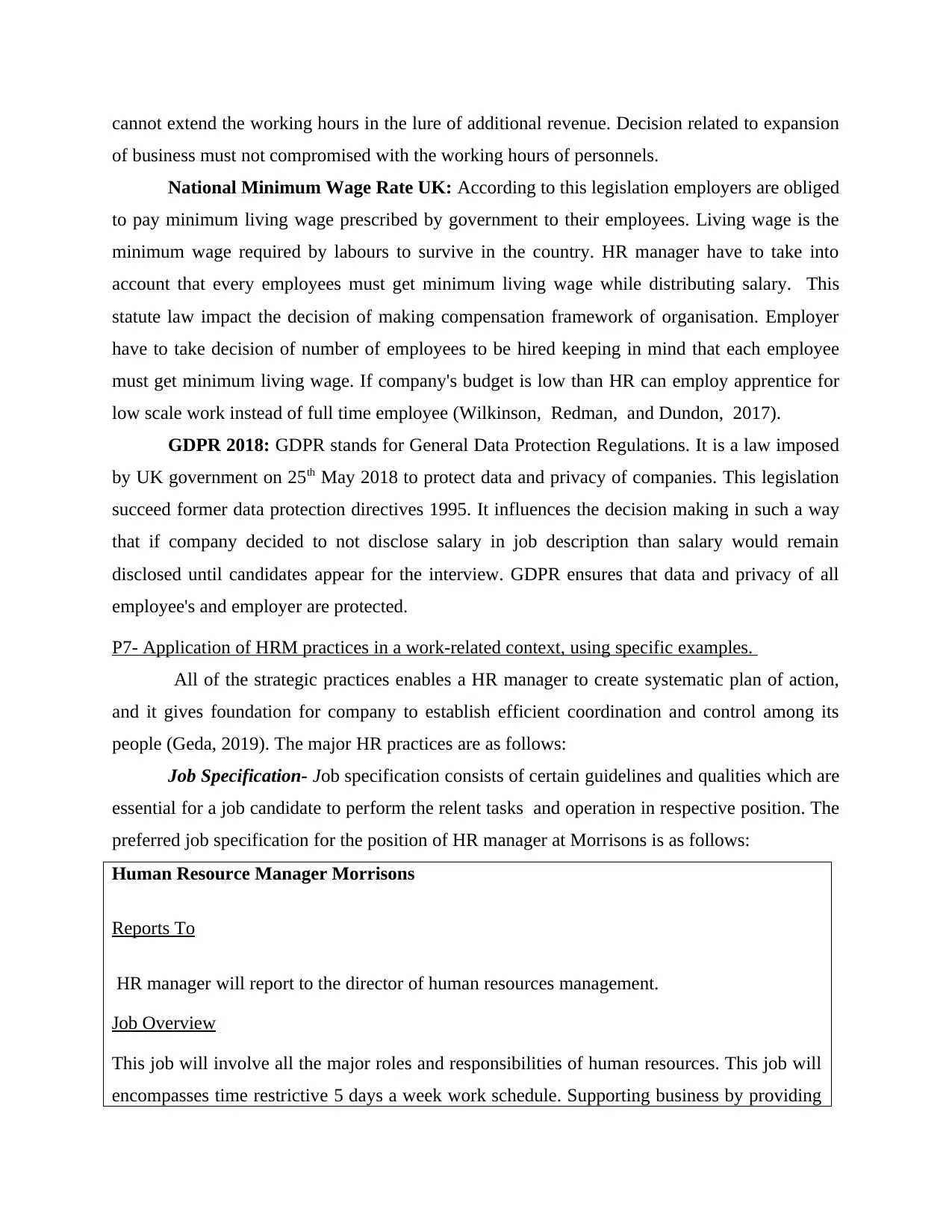
cannot extend the working hours in the lure of additional revenue. Decision related to expansion
of business must not compromised with the working hours of personnels.
National Minimum Wage Rate UK: According to this legislation employers are obliged
to pay minimum living wage prescribed by government to their employees. Living wage is the
minimum wage required by labours to survive in the country. HR manager have to take into
account that every employees must get minimum living wage while distributing salary. This
statute law impact the decision of making compensation framework of organisation. Employer
have to take decision of number of employees to be hired keeping in mind that each employee
must get minimum living wage. If company's budget is low than HR can employ apprentice for
low scale work instead of full time employee (Wilkinson, Redman, and Dundon, 2017).
GDPR 2018: GDPR stands for General Data Protection Regulations. It is a law imposed
by UK government on 25th May 2018 to protect data and privacy of companies. This legislation
succeed former data protection directives 1995. It influences the decision making in such a way
that if company decided to not disclose salary in job description than salary would remain
disclosed until candidates appear for the interview. GDPR ensures that data and privacy of all
employee's and employer are protected.
P7- Application of HRM practices in a work-related context, using specific examples.
All of the strategic practices enables a HR manager to create systematic plan of action,
and it gives foundation for company to establish efficient coordination and control among its
people (Geda, 2019). The major HR practices are as follows:
Job Specification- Job specification consists of certain guidelines and qualities which are
essential for a job candidate to perform the relent tasks and operation in respective position. The
preferred job specification for the position of HR manager at Morrisons is as follows:
Human Resource Manager Morrisons
Reports To
HR manager will report to the director of human resources management.
Job Overview
This job will involve all the major roles and responsibilities of human resources. This job will
encompasses time restrictive 5 days a week work schedule. Supporting business by providing
of business must not compromised with the working hours of personnels.
National Minimum Wage Rate UK: According to this legislation employers are obliged
to pay minimum living wage prescribed by government to their employees. Living wage is the
minimum wage required by labours to survive in the country. HR manager have to take into
account that every employees must get minimum living wage while distributing salary. This
statute law impact the decision of making compensation framework of organisation. Employer
have to take decision of number of employees to be hired keeping in mind that each employee
must get minimum living wage. If company's budget is low than HR can employ apprentice for
low scale work instead of full time employee (Wilkinson, Redman, and Dundon, 2017).
GDPR 2018: GDPR stands for General Data Protection Regulations. It is a law imposed
by UK government on 25th May 2018 to protect data and privacy of companies. This legislation
succeed former data protection directives 1995. It influences the decision making in such a way
that if company decided to not disclose salary in job description than salary would remain
disclosed until candidates appear for the interview. GDPR ensures that data and privacy of all
employee's and employer are protected.
P7- Application of HRM practices in a work-related context, using specific examples.
All of the strategic practices enables a HR manager to create systematic plan of action,
and it gives foundation for company to establish efficient coordination and control among its
people (Geda, 2019). The major HR practices are as follows:
Job Specification- Job specification consists of certain guidelines and qualities which are
essential for a job candidate to perform the relent tasks and operation in respective position. The
preferred job specification for the position of HR manager at Morrisons is as follows:
Human Resource Manager Morrisons
Reports To
HR manager will report to the director of human resources management.
Job Overview
This job will involve all the major roles and responsibilities of human resources. This job will
encompasses time restrictive 5 days a week work schedule. Supporting business by providing
⊘ This is a preview!⊘
Do you want full access?
Subscribe today to unlock all pages.

Trusted by 1+ million students worldwide
1 out of 17
Related Documents
Your All-in-One AI-Powered Toolkit for Academic Success.
+13062052269
info@desklib.com
Available 24*7 on WhatsApp / Email
![[object Object]](/_next/static/media/star-bottom.7253800d.svg)
Unlock your academic potential
Copyright © 2020–2025 A2Z Services. All Rights Reserved. Developed and managed by ZUCOL.





